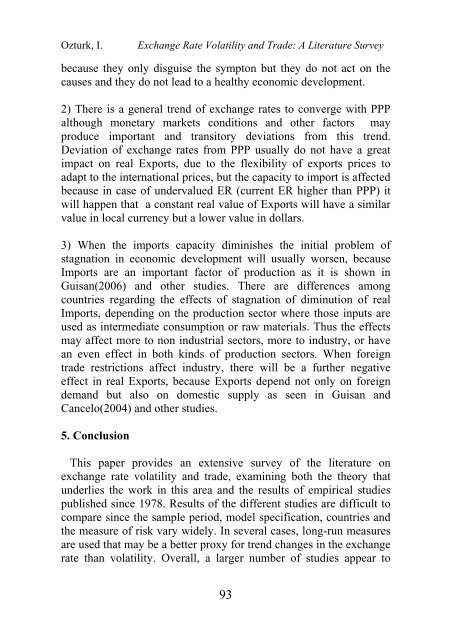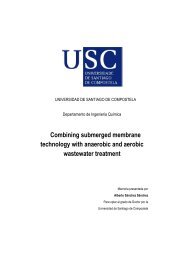EXCHANGE RATE VOLATILITY AND TRADE: A LITERATURE ...
EXCHANGE RATE VOLATILITY AND TRADE: A LITERATURE ...
EXCHANGE RATE VOLATILITY AND TRADE: A LITERATURE ...
You also want an ePaper? Increase the reach of your titles
YUMPU automatically turns print PDFs into web optimized ePapers that Google loves.
Ozturk, I.<br />
Exchange Rate Volatility and Trade: A Literature Survey<br />
because they only disguise the sympton but they do not act on the<br />
causes and they do not lead to a healthy economic development.<br />
2) There is a general trend of exchange rates to converge with PPP<br />
although monetary markets conditions and other factors may<br />
produce important and transitory deviations from this trend.<br />
Deviation of exchange rates from PPP usually do not have a great<br />
impact on real Exports, due to the flexibility of exports prices to<br />
adapt to the international prices, but the capacity to import is affected<br />
because in case of undervalued ER (current ER higher than PPP) it<br />
will happen that a constant real value of Exports will have a similar<br />
value in local currency but a lower value in dollars.<br />
3) When the imports capacity diminishes the initial problem of<br />
stagnation in economic development will usually worsen, because<br />
Imports are an important factor of production as it is shown in<br />
Guisan(2006) and other studies. There are differences among<br />
countries regarding the effects of stagnation of diminution of real<br />
Imports, depending on the production sector where those inputs are<br />
used as intermediate consumption or raw materials. Thus the effects<br />
may affect more to non industrial sectors, more to industry, or have<br />
an even effect in both kinds of production sectors. When foreign<br />
trade restrictions affect industry, there will be a further negative<br />
effect in real Exports, because Exports depend not only on foreign<br />
demand but also on domestic supply as seen in Guisan and<br />
Cancelo(2004) and other studies.<br />
5. Conclusion<br />
This paper provides an extensive survey of the literature on<br />
exchange rate volatility and trade, examining both the theory that<br />
underlies the work in this area and the results of empirical studies<br />
published since 1978. Results of the different studies are difficult to<br />
compare since the sample period, model specification, countries and<br />
the measure of risk vary widely. In several cases, long-run measures<br />
are used that may be a better proxy for trend changes in the exchange<br />
rate than volatility. Overall, a larger number of studies appear to<br />
93

















